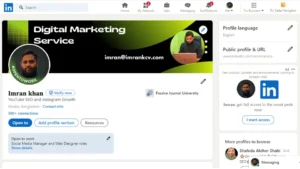
Best LinkedIn Profile Example and Setup
In today’s professional world, having a standout LinkedIn profile is key. LinkedIn is more than just a place to network; it’s a powerful tool for
Through this post you are going to learn how the SEO method works. And using this method how to rank your website in search engines and improve your business.
Actually, this way is still the most effective, so let’s start how it works.
SEO (Search Engine Optimization) strategy refers to a comprehensive plan designed to improve a website’s visibility and ranking on search engine results pages.
Like: Keyword Research, On-Page Optimization, Technical SEO and Link Building, Best SEO Examples, SEO Process, SEO Monthly Plan, Organic Traffic, Keyword Ranking, and Backlinks.
Our first step will start with keyword research. you can use the tool, but before using the tools, I would say that you should create a list of keywords from google search.
Enter Google search and search by typing keywords according to your niche, until you have 10 to 15 key keywords list.
The main reason for taking keywords from Google is that Google has these keywords, which means that people search on these topics.

We will try to get long tail keywords from Google, because it takes less time to rank long tail keywords than short tail keywords.
Long tail keywords have less search volume but by using long tail keywords we will get quick success.
Later I will discuss how to do keyword research using tools like Google Keyword Planner, Ubersuggest and Semrush.
Search Google with one of the keywords you have selected from Google so far and see results. Some sites appear on the first page of Google with these keywords.

After searching, check the websites that appear on the first page to see if their websites have posted about your niche. If so, then your keyword selection is correct.
Semrush will provide a list of competitors based on organic search traffic and other parameters. Explore these lists to identify competitors in your niche.

After identifying competitors, you further analyze their domains to understand their strategies, keywords they rank for, backlink profiles and more.
You can refine your search by specifying parameters such as location, industry or specific keywords.
By following these steps, you can effectively identify your competitors through Semrush. Identifying competitors is only the first step; Analyzing their strategies and applying the insights to your own strategies is crucial to staying competitive in your industry.
Be sure to select four to five candidates and begin their research before leaving Semrush.
Mobile SEO is very important to ensure that your website ranks well in search engine results pages (SERPs) and provides a positive experience for mobile users.
Because the number of mobile users is increasing day by day and they are constantly using the internet through mobile devices.
Responsive Design:
Make sure your website is responsive, meaning it adapts smoothly to different screen sizes and devices. Google prioritizes mobile-friendly websites in its search results
Also, Google recommends responsive design as it makes website management easier.
Page Speed Optimization:
Mobile users expect fast-loading pages Use tools like Google’s PageSpeed Insights to identify and fix issues that could be slowing down your site on mobile devices.
Mobile-first indexing:
Make sure your mobile site has the same content as your desktop site and is optimized for search engines.
Create content that is easy to use on mobile devices. These include short paragraphs, bullet points, and clear headings. Better to avoid large blocks of text and images.
Mobile-friendly navigation:
Make sure your content is easy to read and navigate on mobile devices Use short paragraphs, bullet points, and subheadings to improve readability.
Make it easy for mobile users by using dropdown menus, hamburger menus, or other mobile-friendly navigation patterns. Make sure buttons and links are easily clickable on the touch screen.
Local SEO:
Optimize for local search, especially if you have a physical location. This includes optimizing your Google My Business listing, using local keywords and making sure your address is consistent across all platforms.
Structured Data Markup:
Apply schema markup to provide search engines with additional context about your content. This can increase your chances of appearing in rich snippets and other rich search results, especially on mobile devices.
Optimize Metadata:
Write catchy and concise title tags and meta descriptions optimized for mobile search results. Character limit should be kept in mind for mobile display.
Mobile-Specific Keywords:
Research and use keywords that are more likely to be used in mobile searches. This can include “near me” searches or shorter, more conversational questions.
Optimize images and videos:
Use descriptive filenames and alt tags for images and videos to improve visibility in image and video search results.
Compress images to reduce loading time without compromising quality. Use web-optimized formats like WebP, Png, Jpg or JPEG XR
If you have a mobile app, optimizing it for App Store search is very important.
User Experience (UX) Optimization:
Provide a seamless and intuitive user experience on mobile devices. Make sure buttons and links are easily clickable, forms are easy to fill out, and navigation is simple.
Mobile Site Security:
Ensure your mobile site is secure by implementing HTTPS encryption. Google considers HTTPS as a ranking factor and warns users when they try to access unsecured sites, which can negatively impact your SEO efforts.
Optimize for voice search:
With the rise of voice assistants, optimize your content for voice search queries by incorporating natural language and long-tail keywords.
Monitor and analyze performance:
Regularly monitor your mobile site’s performance using tools like Google Analytics and Google Search Console.
Use this data to identify areas for improvement and refine your mobile SEO strategy accordingly.
Test your website on mobile devices to ensure it loads correctly and works smoothly on different platforms and screen sizes.
By implementing these strategies, you can improve your mobile SEO and provide a better experience for users accessing your site on mobile devices, which ultimately leads to higher rankings and increased organic traffic.
Generally, SEO is divided into three parts and an SEO specialist works on these three methods to bring a website to the first page of search engines.
On-page SEO is important for optimizing individual web pages to rank higher and earn more relevant traffic on search engines.
Keyword Research:
Content Optimization:
URL Structure:
Heading (H1, H2, etc.):
Internal linking:
External linking:
Regular content updates:
It implements On-page SEO best practices. Hence you will perform mandatory tasks to improve the visibility, relevance, and user experience of your website.
Off-page SEO refers to activities outside of your website that impact your search engine rankings. Here’s a comprehensive off-page SEO strategy:
Link Building:
Acquiring backlinks from reputable and relevant websites is crucial for off-page SEO.
Quality backlinks act as votes of confidence in your website’s credibility and can significantly boost your search engine rankings.
This can be done through techniques like guest posting, broken link building, resource page link building, and outreach to influencers and bloggers in your niche.
Social Media Engagement:
Influencer Outreach:
Content Syndication:
Online PR and Brand Mentions:
Forum Participation and Q&A Sites:
Social Bookmarking:
Monitor and Analyze:
Press Releases:
Guest Blogging:
Off-page SEO is an ongoing process that requires consistent effort and adaptation to changes in search engine algorithms and industry trends.
Focus on building a diverse and natural backlink profile while also nurturing relationships with your audience and industry influencers.
Optimizing the technical aspects of your website is essential to improve search engine visibility and performance.
Website Speed Optimization:
Mobile-Friendliness:
Website Structure and Navigation:
XML Sitemap:
Robots.txt:
Canonicalization:
Schema Markup:
HTTPS Security:
URL Structure Optimization:
404 Error Handling:
Website Security and Maintenance:
By implementing these technical SEO strategies, can improve your website’s crawlability, indexability, and overall performance in search engine rankings.
Regular monitoring and optimization are essential to staying ahead of algorithm updates and maintaining a comp.
Of course, alt text is important for both accessibility and SEO.
Image Alt Text Optimization:
Assign descriptive alt text to all images on your website describing the content or purpose of each image
Include relevant keywords in the alt text where appropriate, but make sure it accurately describes the image.
Keep alt text short and descriptive. For decorative or non-informative images, use empty alt attributes (`alt=””`) that are purely decorative.
For embedded videos, provide descriptive alt text that summarizes the video content or its purpose.
If the video contains spoken content, consider providing a transcript and linking to it in the alt text.

Make sure alt text is implemented correctly in your website’s HTML markup by using the `alt` attribute within the `<img>` tag.
Use a content management system (CMS) or website builder that allows easy insertion and editing of alt text for images.
Alt text serves as an important accessibility feature for those who rely on screen readers or disable images in their browsers.
Alt text provides additional context to search engines, helping them understand the content and relevance of images on your website.
Including relevant keywords in alt text can improve image search rankings and drive additional organic traffic to your website.
Alt text also contributes to the overall keyword relevance and semantic understanding of your web pages.
Periodically audit your website to ensure that all images have descriptive alt text.
Update alt text when images are added, removed or their content changed to maintain accuracy and relevance.
By optimizing your website’s alt text, you not only increase accessibility for all users but also improve your site’s SEO performance by providing search engines with valuable context about your images.
(SEO-friendly alt text, metadata and URL slugs for you.)
Link building needs to be discussed in detail. The previous discussion was brief
Building a strong backlink profile is immense in improving your website’s authority and search engine rankings.
Because no matter how important your information is, if you don’t have backlinks, Google won’t rank you
Create high-quality, valuable content that naturally attracts backlinks from authoritative websites.
Ensure your content is relevant to your target audience and addresses their needs or interests.
Conduct keyword research to identify topics with high search volume and potential for backlink acquisition.
Analyze your competitors’ backlink profiles to see potential link opportunities.
Identify websites linking to your competitors and assess whether you can also obtain backlinks from those sources.
Identify reputable websites and blogs in your niche that accept guest contributions.
Pitch well-researched and unique content ideas to these websites, including a relevant backlink to your own content within the guest post.
Find broken links on authoritative websites in your niche using tools like Ahrefs, SEMrush, or Check My Links Chrome extension.
Reach out to the website owner or webmaster, notifying them of the broken link and offering your content as a replacement.

Identify resource pages within your industry and, that list useful websites, tools, or articles.
Reach out to the owners of these resource pages, suggesting your content as a valuable addition and requesting a backlink.
Identify popular content in your niche with a high number of backlinks.
Create similar, but more comprehensive, informative, and updated content.
Reach out to websites linking to the original content, informing them of your improved version and requesting a backlink.
Build relationships with influencers and thought leaders in your industry through social media, email, or networking events.
Collaborate on content projects or ask for endorsements, testimonials, or mentions that include backlinks to your website.
Reach out to the authors or publishers of these mentions, thanking them for the mention and politely requesting a backlink.
Syndicate your content on reputable platforms, such as Medium, LinkedIn Pulse, or industry-specific forums and communities.
Include backlinks to your website within the syndicated content, directing readers back to your original source.
Engage with webmasters, bloggers, and influencers in your niche by commenting on their blogs, sharing their content, or offering assistance.
Building genuine relationships can lead to natural backlink opportunities over time.
Regularly monitor your backlink profile using tools like Google Search Console, or SEMrush.
Disavow toxic or spammy backlinks that could harm your website’s reputation or rankings using Google’s Disavow Tool.
Use a variety of anchor texts, including branded, exact match, and partial match anchors, to ensure a natural backlink profile.
Track the number of backlinks, referring domains, and the quality of backlinks using SEO tools.
Monitor changes in search engine rankings and organic traffic to assess the impact of your backlink building efforts.
Consistency, patience, and persistence are key to executing a successful backlink SEO strategy.
Focus on acquiring high-quality backlinks from authoritative sources while adhering to best practices and avoiding manipulative tactics that could harm your website’s reputation.
Have you started SEO for your website, if not then start now.
If you can’t do it yourself, you can take the help of some SEO experts, Fiverr is good for low cost.
Here are some Fiverr gigs you can see.

Check out my post and video on how to easily hire and work as a freelancer from Fiverr.
Thank You.

In today’s professional world, having a standout LinkedIn profile is key. LinkedIn is more than just a place to network; it’s a powerful tool for

Audio editing is key for anyone wanting to boost their sound quality. It’s essential for music production, podcasts, or film. With the right tips, I

I’ve always searched for the best tools to improve my digital photos. Whether you’re a pro or just for fun, the right online photo editor

In today’s fast-paced digital world, having a strong LinkedIn marketing strategy is key for professionals. It helps them get noticed and connect with others who

In today’s fast-paced retail world, Point of Sale Marketing is key. I’ll show how POS Marketing can make checkout better and increase sales. The time

Starting a business is exciting and a bit scary. That’s why a good business plan is key. This guide will show you why a detailed

In today’s fast business world, knowing how to manage a supply chain is key. It’s vital for any company wanting to be efficient and successful.

Project management is a key skill set that helps ensure projects run smoothly. It includes many activities and methods. In today’s fast business world, knowing